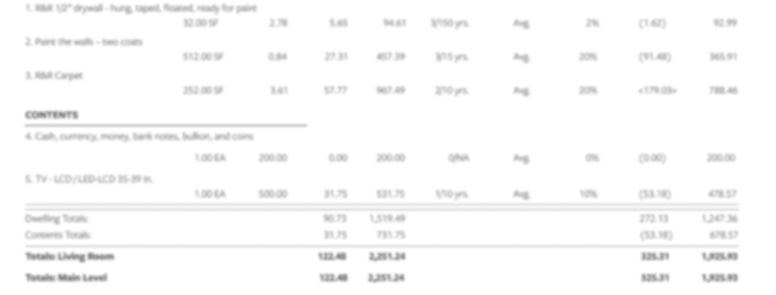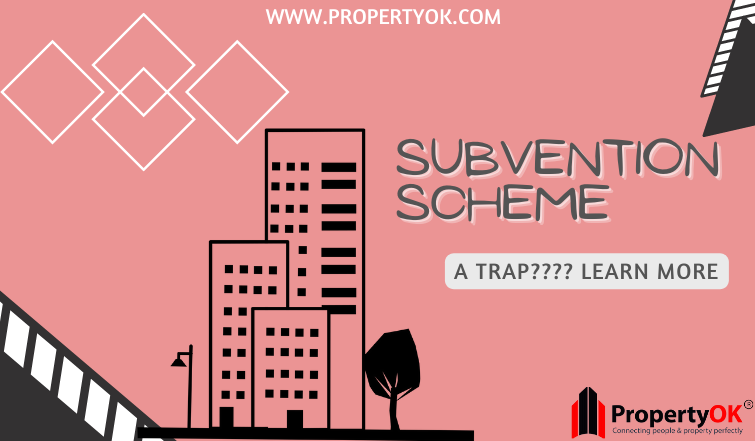Subvention schemes can be a lucrative investment opportunity – with promises of immediate returns and the possibility of handsome profits. But unfortunately, they can also be dangerous traps for the unwary investor. Subvention schemes are popular amongst real estate developers as they allow them to attract buyers with alluring terms and discounts while offering investors anything from upfront payments to deferred payments.
This article will explore how subvention schemes work and why they can be risky investments for individuals, businesses, and even governments.
Start living your best life: Let us help you find a home that perfectly fits your lifestyle and needs.

What is Subvention Scheme?
The Subvention Scheme is a scheme that has been designed to help investors who are looking to invest in a property. This scheme allows the investor to put down a deposit on a property, and then the remaining amount is paid by the government over a while. This scheme has been designed to help those looking to invest in a property but may not have the full amount required upfront.
Also Read:
LEASE AGREEMENT: A RECIPE FOR DISASTER OR A SAFE BET?
How do Subvention Schemes Work?
Subvention schemes are a type of financial incentive developers offer buyers to encourage new property sales. The scheme typically works by the developer offering to pay a portion of the buyer’s mortgage interest for a set time, usually 2-5 years. This can be attractive for buyers looking to get on the property ladder with a relatively low deposit, as it reduces their monthly repayments. However, there are several potential pitfalls that buyers should be aware of before entering into such a scheme.
Firstly, it is important to remember that the developer is not paying your mortgage interest – they are simply deferring it. This means you will still have to pay back the full mortgage amount at the end of the term, plus any interest that has accrued. Secondly, sell your property during the subvention period. You will likely have to pay back a proportion of the subsidy you received from the developer (known as a ‘clawback’). Finally, it is worth noting that subvention schemes can potentially create negative equity situations, where you owe more on your mortgage than your property is worth.
Given these potential risks, buyers must seek independent financial advice before entering any subvention scheme.
What is Subvention Scheme in real estate?
The Subvention Scheme is a scheme developers use to entice buyers to purchase a property. The developer provides an interest-free loan to the buyer, which need not be repaid until the property is sold or refinanced. The developer pays the interest on this loan for the first few years, after which the buyer needs to start paying it. This scheme can be availed of by buyers who are looking to purchase a property under construction.
The main aim of this scheme is to make buying a property more affordable for buyers. However, buyers must be aware of certain risks of this scheme before availing of it. One of the biggest risks is that if the property doesn’t sell or get refinanced within the specified time frame, then the buyer will have to start paying back the loan with interest. This can become a financial burden for buyers, especially if they have taken out a large loan amount.
Another risk of this scheme is that the buyer will be liable if the developer defaults on their payments. This means buyers must do their due diligence on the developer before availing of this scheme. Before deciding, they should check the developer’s track record, financial stability, and project delivery history.
Despite these risks, many buyers still opt for subvention schemes as it allows them to purchase their dream home without worrying about the immediate financial burden.
Read More:
BEWARE OF FAKE LAND SURVEY NUMBER: HOW TO SPOT A SCAM
What is Builder Subvention Scheme?
The builder subvention scheme is a type of promotion where the builder pays a portion of the buyer’s closing costs. It’s generally an incentive for buyers to purchase a home from a particular builder. While subvention schemes can offer significant savings to buyers, there are some potential risks that buyers should be aware of before taking advantage of such a promotion.
First and foremost, it’s important to understand that the builder is not required to pay the buyer’s closing costs under this arrangement – they’re simply offering it as an incentive. If the buyer defaults on their loan or fails to complete the purchase, the builder is not obligated to reimburse them for expenses. Additionally, many builders require that buyers use their in-house financing to take advantage of the subvention scheme – meaning that buyers may end up with a less favorable interest rate than they could have obtained elsewhere.
Finally, it’s important to remember that Builder Subvention Schemes typically only apply to new construction homes. If you’re considering purchasing a resale property, you won’t be able to take advantage of this type of promotion.
If you’re considering taking advantage of a builder subvention scheme, do your homework and understand the potential risks before making any commitments.
Subvention Scheme projects in Mumbai
Subvention schemes are a type of housing finance scheme in which the developer pays a part of the interest on the loan taken by the buyer. The idea behind these schemes is to make homes more affordable for buyers who would otherwise be unable to purchase a property.
While subvention schemes may seem like a good deal for buyers, they can be risky. This is because developers often use these schemes to lure in buyers without having the funds to complete the project. This can leave buyers stuck with an incomplete home and a large loan to repay.
Suppose you’re considering purchasing a property under a subvention scheme. In that case, it’s important to do your research and ensure that the developer is reputable and has the financial ability to complete the project. Otherwise, you could lose your investment and be left with an unfinished home.
Subvention Scheme under RERA
The Subvention Scheme is under the Real Estate (Regulation and Development) Act, 2016 (RERA), which allows an investor to pay only a certain percentage of the apartment price as the down payment, with the remaining amount being paid by the developer to the financial institution.
The developers are allowed to recover this amount from the buyers at the time of the sale of the property. The idea behind this scheme is to make housing affordable for buyers who otherwise would not be able to afford it.
However, there have been several instances where developers have used this scheme to trap unwary buyers. In some cases, developers have promised subvention but failed to deliver. In other cases, buyers have been duped into paying higher prices for properties that are not eligible for subvention.
Buyers should therefore be cautious when considering a subvention scheme. They should verify that the developer is registered with RERA and check if the project is listed on RERA’s website. They should also read all the scheme details carefully before signing any agreement.
Read More:
INDIA’S AFFORDABLE HOUSING CRISIS: IS THERE ANY HOPE FOR A SOLUTION?
Pros and Cons of Subvention Schemes
There are many pros and cons to subvention schemes that potential investors should be aware of before Entering into any subvention scheme. Some of The pros include:
–Lower interest rates: One of the main advantages of a subvention scheme is that it offers lower interest rates than what is available on the open market. This can save the investor a significant amount of money over the life of the loan.
–Flexible terms: Another advantage of a subvention scheme is that it offers more flexible terms than traditional loans. This can benefit investors who need to sell their property before the end of the loan term.
–No prepayment penalties: A final advantage of a subvention scheme is that there are no prepayment penalties. This means that investors can sell their property at any time without paying the penalty.
However, there are also some potential drawbacks to subvention schemes that investors should be aware of, including the following:
–Higher risks: One of the main disadvantages of a subvention scheme is that it is a higher-risk investment than traditional loans. This means there is a greater chance that the investor will default on the loan and lose their investment.
–Less flexibility: Another disadvantage of a subvention scheme is that it offers less flexibility than traditional loans. This can be problematic for investors who need to sell their property before the end of the loan term.
–Potential scams: A final disadvantage of a subvention scheme is the risk of scams. Investors should research before entering any subvention scheme to ensure they are dealing with a legitimate lender.
Are Subvention Schemes Legal?
The subvention scheme is a popular marketing technique developers use to lure buyers by promising them a refund of a portion of the purchase price. However, many buyers are unaware that these schemes may be illegal and that they may be left without any legal recourse if things go wrong.
Under the subvention scheme, the developer promises to pay back a certain percentage of the purchase price to the buyer over time. Usually, this money is supposed to come from the sale of other units in the project. However, in many cases, developers have been known to use other methods to fund the refunds, such as taking out loans or even using black money. This can leave buyers in a precarious position, especially if the project is not completed on time.
In addition, many buyers are unaware that they may have to pay income tax on the refund they receive from the developer. This can be quite a shock when they receive their first tax bill!
So, if you’re considering investing in a property with a subvention scheme, do your homework first. Speak to a lawyer or financial advisor to better understand the risks involved. And always remember, if something sounds too good to be true, it probably is!
Also Read:
INVESTING IN REITS IN INDIA: WHY YOU SHOULD THINK TWICE BEFORE TAKING THE PLUNGE
Alternatives to Subvention Schemes
There are several alternatives to subvention schemes that investors can consider. One option is to invest in a property without needing a loan. This can be done by paying cash upfront or taking out a mortgage. Another option is to invest in property not part of a subvention scheme. This could be done by purchasing an existing property or investing in a new build property not part of a subvention scheme. Investors can consider other options, such as renting, leasing, or investing in shares or other securities.
Conclusion
Subvention schemes can greatly reduce the burden of upfront costs and make property investment more accessible. However, they also come with risks that are not often immediately obvious to the investor. Potential investors need to familiarise themselves with all subvention schemes before signing on any dotted line and ensure they understand their obligations should something go wrong during or after construction. By doing due diligence and ensuring that you are aware of the terms of the scheme, you can avoid getting caught in a subvention trap!
Frequently Asked Questions:
1. Can a home buyer opt out of Subvention Scheme?
Yes, home buyers can always opt out of subvention schemes. It is important to know that when opting out of a subvention scheme, the home buyer will be responsible for all the costs involved in completing the transaction. We highly recommend that before investing, one thoroughly understands and weighs the pros and cons of a subvention scheme against their financial goals.
2. Is it okay to purchase flat in Interest Subvention Scheme?
Before making a purchasing decision concerning an interest subvention scheme, knowing what you are getting into is important. There are many factors to consider when evaluating the benefits and risks associated with such a scheme. While an interest subvention scheme can benefit some investors, others may find themselves less-than-optimal if they haven’t thoroughly researched. Before taking advantage of such schemes, we advise real estate investors and entrepreneurs to fully understand the terms and conditions, including how long the interest benefit will last and any potential pitfalls or restrictions.
3. What are the latest subvention schemes?
Subvention schemes are becoming increasingly popular as real estate investors, middle-class individuals, and entrepreneurs seek ways to finance their investments. There are many different subvention schemes on the market. Still, some of the most popular include schemes with developers offering to pay part or all of the deposit, no monthly payments until completion, no service charges until completion, and deferred payment plans. We recommend anyone considering a subvention scheme research to speak to an expert before committing to one.

 Thank You
Thank You




